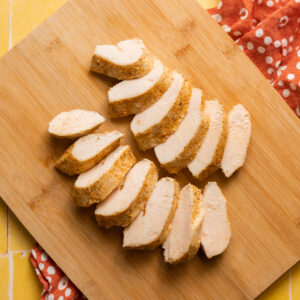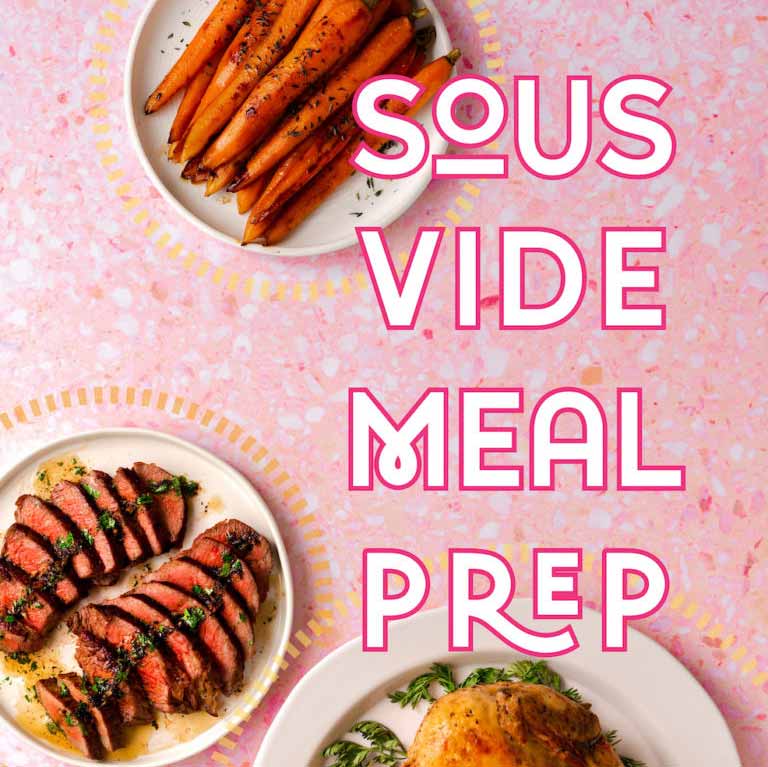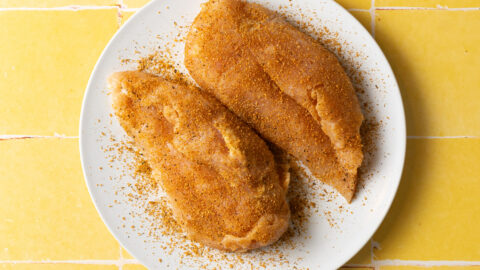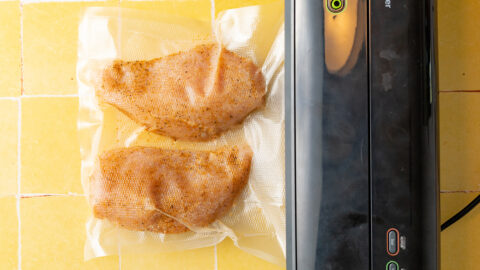The best way to make sure your boneless skinless chicken breasts are tender and juicy every single time is with sous vide. This method is so simple and truly foolproof! This recipe also works for chicken tenders and you can use frozen chicken, no problem.

Sous vide may just be the easiest way to cook chicken breasts and they will come out perfectly every single time. If you’re new to sous vide and simply wondering what sous vide is, this recipe is a great way to get started with your immersion circulator.
Season, vacuum seal, drop in water bath, and that’s it! You can even sous vide whole chicken and chicken thighs. With this method, your chicken will be chicken-ier, juicier, and just cooked better than oven-cooked chicken every time.
I have tons of recipes in my cookbooks to make your sous vide chicken breasts delicious, including rubs, marinades, and sauces.
Sous Vide Meal Prep
This cookbook outlines my entire method for keeping your freezer stocked with ready to sous vide meals (and some great recipes to boot!).
Why sous vide chicken breasts?
Yes, there are plenty of other ways to cook chicken breasts that are easy. So, why sous vide them? A few reasons!
- They will be cooked perfectly. Always juicy, always exactly how you like.
- All you have to do is drop them into a water bath and set a timer, leaving you free to make side dishes or go about your day. No babysitting.
- Practically no clean up. Just toss the vacuum seal bag when you’re done or put your reusable bag in the dishwasher!
- You can go straight from the freezer to the sous vide water bath, no defrosting required.
Once you sous vide chicken breasts, you’ll never go back. I’ve heard from so many people that they didn’t really care for them before trying sous vide – they were dry, boring, etc. In fact, the same goes for most cuts of chicken!
Time and Temperature Options
The below times and temps are for boneless, skinless chicken breasts that aren’t frozen. If you are using bone-in or frozen boneless chicken breasts, add an hour to the minimum cook time.
My favorite time and temperature for sous vide chicken breasts is 1-2 hours at 150 degrees F.
| Result | Temp | Time | Time (Frozen) |
|---|---|---|---|
| Very soft texture, little moisture loss | 140 degrees F 60 degrees C | 2-4 Hours | 3-4 Hours |
| Tender and close to “traditional” texture, still juicy | 150 degrees F 65 degrees C | 1-4 Hours | 2-4 Hours |
| Traditional texture, slightly stringy, more moisture loss | 160 degrees F 71 degrees C | 1-4 Hours | 2-4 Hours |
Can I overcook chicken in sous vide?
The short answer is no, you can’t overcook chicken with sous vide! Since the cooking environment is the temperature you want your meat to come to, it’s impossible to overcook. Pretty cool, huh?
However, if you leave it in the water bath too long, you can over tenderize it and make it a bit mushy. This is why I suggest never cooking chicken breasts longer than 4 hours.
Why can I cook chicken at a lower temp than 165 degrees F when sous viding?
The information provided by experts like the USDA around food safety often sacrifices detail in favor of being easy to understand. Which I get! But 165 degrees F isn’t the full story.
Temperature guidelines are there to make sure you kill bacteria, the big one being salmonella when we’re cooking chicken. We want to pasteurize the chicken. Pasteurization is related to both time AND temperature.
The reason 165 degrees F is the gold standard is because chicken is instantly pasteurized at that temperature. The lowest temperature I offer for cooking chicken is 140 degrees F. If your chicken is 140 degrees F all the way through for at least 27.5 minutes, it will be pasteurized! And I recommend a minimum of 2 hours to allow for plenty of time for it to get to temperature and be there for far longer than 27.5 minutes.
At 145 degrees F you only need 9.2 minutes, at 150 degrees F you only need 2.8 minutes, and at 155 degrees F you only need 47.7 seconds! Pretty neat, huh?
To learn more about this, I recommend this article from Serious Eats.
Equipment You’ll Need
The good news is, if you already sous vide, you should have all the equipment required to prepare sous vide chicken breasts. The list is short!
- An immersion circulator – I recommend the Joule
- A container (you can just use a stockpot, or my favorite sous vide containers are Everie containers)
- A vacuum sealer or simply a plastic zipper top bag. I have a blog post all about air removal methods to help you out!
What if I don’t have a vacuum sealer?
If you don’t have a vacuum sealer, there are lots of other air removal methods you can use with zipper top, freezer safe bags or reusable silicone bags, like Stasher Bags. Thanks to these methods, a vacuum sealer is more of a convenience thing and I find it comes in handy when I’m batch prepping food for the freezer to sous vide later!
Marinades and Seasoning Options
The process for chicken breasts is so simple – another reason it’s one of my favorite proteins for sous vide cooking!
For flavor, you have a few choices:
- Add the chicken breasts to a marinade in a bag, like my BBQ Chicken Marinade. Yes, you can cook the chicken breasts in the marinade! In fact, the marinade makes a great sauce.
- Season with a seasoning blend or rub. Homemade or store-bought!
- Simply season with salt and pepper. I always use Diamond Crystal Kosher Salt and freshly cracked black pepper.
Don’t forget about a great sauce, like my Spicy Chimichurri or any of my other sauce recipes.
Tips for Cooking Sous Vide Chicken Breasts Perfectly
- After sealing your chicken breasts in a vacuum seal bag, you can cook immediately, refrigerate for up to 3 days, or freeze to cook later.
- When you’re ready to cook, place in a preheated water bath set to your desired temp from the chart below for 1-4 hours (add an hour when cooking from frozen or for bone-in chicken breasts).
- If you want to, you can sear them in a skillet with olive oil or butter when they’re done, but usually I don’t bother.
Common Questions
Absolutely. Just make sure they aren’t stacked, even better if they aren’t quite touching. You want water to be able to surround each of the chicken breasts for the most even cook.
Yes you can! I do it all the time. Just add about an hour of cook time.
Pick your favorite temperatures from the above chart (145-155 degrees F) and increase the minimum cook time by 1 hour for bone-in chicken breasts.
This recipe will work for chicken tenders, too! No adjustments needed.
You can for color and texture, but there’s no need if you don’t want to. I typically don’t sear my chicken breasts.
You can also view this recipe as a step-by-step web story here.

Get the Recipe:
Fool-Proof Sous Vide Chicken Breasts
Ingredients
- 3-4 boneless skinless chicken breasts
- kosher salt, optional
- freshly cracked black pepper, optional
Instructions
Prep
- Season chicken breasts with salt and pepper or your favorite spice blend.
- Add to vacuum seal bag and remove the air and seal, or use a freezer safe zipper top bag and another air removal method.
- At this point, you can freeze the chicken breasts or sous vide immediately. If sous viding immediately, preheat a water bath according to the options below and cook according to the times below.
Sous Vide Time and Temperature Options
- Very soft texture, little moisture loss: 140 degrees F: 2-4 Hours (3-4 if frozen or bone-in)
- Tender and close to “traditional” texture, still juicy: 150 degrees F: 1-4 Hours (2-4 if frozen or bone-in)
- Traditional texture, slightly stringy, more moisture loss: 160 degrees F: 1-4 Hours (2-4 if frozen or bone-in)
To Finish
- Finishing after sous viding is optional for chicken breasts. If you do want to finish, I recommend a pan sear. Heat a skillet over medium-high heat.
- Once hot, add butter or oil. Sear until browned, about 1 minute on each side.





